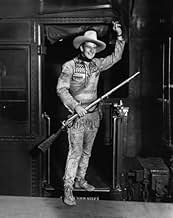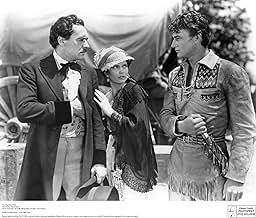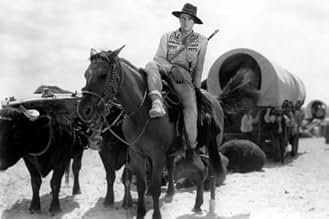Breck Coleman conduit des centaines de colons en chariots couverts depuis le fleuve Mississippi vers leur destin dans l'Ouest.Breck Coleman conduit des centaines de colons en chariots couverts depuis le fleuve Mississippi vers leur destin dans l'Ouest.Breck Coleman conduit des centaines de colons en chariots couverts depuis le fleuve Mississippi vers leur destin dans l'Ouest.
- Réalisation
- Scénario
- Casting principal
- Récompenses
- 5 victoires au total
- Red Flack
- (as Tyrone Power)
- Wagon Train Man
- (non crédité)
- Pioneer
- (non crédité)
- Indian
- (non crédité)
- Sid Bascom
- (non crédité)
- Pioneer
- (non crédité)
- Wrangler
- (non crédité)
- Pioneer Child
- (non crédité)
Avis à la une
That alone makes "The Big Trail" a technically significant film. Word has it that it failed economically, in part due to only two U.S. theatres presenting its original format (NYC's Roxy and LA's Grauman's Chinese Theatres). The rest of the country's movie houses balked at the cost of the extra equipment necessary, after having recently converted to sound. (Does this seem reminiscent of the "'Star Wars' digital satellite controversy" of 2002?)
Finding a VHS or DVD widescreen print of "The Big Trail" is difficult. It's been shown on tv and in special movie houses that way on occasion. Generally, though, one gets a standard screen version, which fails to capture the eye-popping 70 mm. aspect ratio of the original.
The production's statistics are impressive--a 347 cast/crew, covering 7 states in 10 weeks, replete with wagons, cattle, oxen, mules, horses, et al., retracing the first settler's trek over the Oregon trail one hundred years earlier.
Twenty year old Marion Morrison was renamed John Wayne and teamed with nineteen year old Broadway actress Margurite Churchill for a hoped-for "hot screen combination." The two worked efficiently, with Wayne's untrained, natural talent in evidence.
The production looks very laborious and challenging--yet appropriate to the conditions of those early pioneers. European "superiority" vs. Native American "savagery" is expressed in the script--establishing a skewed perspective for numerous films to follow. Likewise, macho "frontier justice" is forcefully dramatized--a model for many later western efforts.
"The Big Trail," while a technical landmark, also presents a Hollywoodized depiction of American history. For a more complete understanding of this period and these events, one is prone to engage in more committed and comprehensive research.
Early movies could use or consult people WHO HAD BEEN THERE. Of course, USC quarterback John Wayne, or even Irish thespian Tyrone Power, Sr. (who tried farming and hated it) are exceptions, but there is a ring of authenticity with "The Big Trail" which you can't get second hand. And if those aren't real plains Indians by the hundreds, I'll eat my breech clout!
And the scenery! Unfortunately, cinematographers hadn't mastered filters, so the sky is always washed out, and dust and haze obscure the deep focus. But even these limitations paradoxically serve to provide a feel of endless horizons. And the locations are spectacular, especially the Indian village, which is so enormous that at first I thought half of it was backdrop. Then, there is the spectacular rope drop of animals and equipment down an escarpment that could have inspired Herzog's "Fizcarraldo".
Of course, the acting is hammy and dialog corny, but remember, The Big Trail is from 1930 and that early sound movies had yet to evolve fully from silent film technique, which called for pantomime, with its exaggerated facial expression and movement. Also bear in mind that the style of reading lines came directly from the theater stage from which lines, lacking voice amplification, were delivered as oratory to be heard in the back rows.
Robert Flaherty in his landmark documentary "Nanuk of the North" actually set up his scenes dramatically. He was by no means a fly on the wall. If Flaherty could have made a documentary about the epic journey of a pioneer wagon train through the great Western prairies, I doubt if he could have achieved much greater impact than "The Big Trail".
Le saviez-vous
- AnecdotesIncredibly, six different versions of this film were shot simultaneously: (1) a 70mm version in the Grandeur process for exhibition in the biggest movie palaces, (2) a standard 35mm version for general release, (3) a 35mm alternate French-language version La piste des géants (1931)', (4) a 35mm alternate Spanish-language version La gran jornada (1931), (5) a 35mm alternate German-language version Die große Fahrt (1931), and (6) a 35mm alternate Italian-language version Il grande sentiero (1931). The four alternate-language versions were shot with (mostly) different casts.
- GaffesBased on the 26 star flag (1837-1845), the film takes place in the 1840s. Many of the settlers use Springfield Model 1873 "trapdoor" rifles. This was common in Hollywood because the 1873 was based on the 1861 rifled musket, which closed a continuous line of muskets going back to 1795, so it easily could stand in for a muzzle loading musket to the untrained eye.
- Citations
Breck Coleman, Wagon Train Scout: We can't turn back! We're blazing a trail that started in England. Not even the storms of the sea could turn back the first settlers. And they carrie dit on further. They blazed it on through the wilderness of Kentucky. Famine, hunger, not even massacres could stop them. And now we picked up the trail again. And nothing can stop us! Not even the snows of winter, nor the peaks of the highest mountain. We're building a nation and we got to suffer! No great trail was ever built without hardship. And you got to fight! That's right. And when you stop fighting, that's death. What are you going to do, lay down and die? Not in a thousand years! You're going on with me!
- Crédits fousOpening credits prologue: DEDICATED- To the men and women who planted civilization in the wilderness and courage in the blood of their children.
Gathered from the north, the south, and the east, they assemble on the bank of the Mississippi for the conquest of the west.
- Versions alternativesFilmed in two versions simultaneously: widescreen process Grandeur in 70mm, and in standard 35mm. Some scenes were shot simultaneously in both formats; other scenes were shot twice, once for each format. The two versions are not identical in content - the 70mm version runs 125 minutes, while the 35mm version runs a shorter 108 minutes (but does contain some scenes not found in the longer widescreen version).
- ConnexionsAlternate-language version of La gran jornada (1931)
Meilleurs choix
- How long is The Big Trail?Alimenté par Alexa
Détails
Box-office
- Budget
- 2 000 000 $US (estimé)
- Durée2 heures 5 minutes
- Couleur
Contribuer à cette page




































